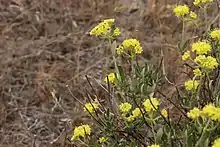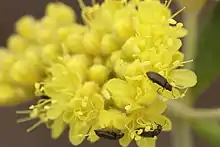Eriogonum sphaerocephalum
Eriogonum sphaerocephalum is a species of wild buckwheat known by the common name rock buckwheat. It is native to the western United States primarily east of the crest of the Cascade Range in Washington and Oregon to Idaho and from southern Oregon and northern California to northern Nevada. It is a common member of desert, rocky and sagebrush steppe habitats.[1][2] Eriogonum sphaerocephalum is found over a wide range of elevations, but is most common between 2,000–7,000 feet (600–2,100 m).
| Eriogonum sphaerocephalum | |
|---|---|
 | |
| Scientific classification | |
| Kingdom: | Plantae |
| Clade: | Tracheophytes |
| Clade: | Angiosperms |
| Clade: | Eudicots |
| Order: | Caryophyllales |
| Family: | Polygonaceae |
| Genus: | Eriogonum |
| Species: | E. sphaerocephalum |
| Binomial name | |
| Eriogonum sphaerocephalum | |
Description

Eriogonum sphaerocephalum is a small shrub or subshrub up to 50 cm (20 in) tall and wide, growing from a caudex and producing erect flowering stems. The woolly leaves are widely lance-shaped to somewhat oval and 1–4 cm (0.4–1.6 in) long, and form basal rosettes around the caudex.[3][4]
The inflorescence arises on a stalk and bears many yellow flowers in a head-like cluster or umbel.
Varieties
There are several varieties of this species:
- E. s. var. fasciculifolium is endemic to Idaho.
- E. s. var. halimioides is a widespread variety with very pale yellow flowers.
- E. s. var. sphaerocephalum has bright yellow flowers.
References
- Sullivan, Steven. K. (2020). "Eriogonum sphaerocephalum". Wildflower Search. Retrieved 2020-09-22.
- USDA, NRCS. (2020). "Eriogonum sphaerocephalum". The PLANTS Database. National Plant Data Team, Greensboro, NC 27401-4901 USA. Retrieved 2020-09-22.
- Giblin, David (Editor) (2020). "Eriogonum sphaerocephalum". WTU Herbarium Image Collection. Burke Museum, University of Washington. Retrieved 2020-09-22.CS1 maint: extra text: authors list (link)
- "Eriogonum sphaerocephalum". in Jepson Flora Project (eds.) Jepson eFlora. Jepson Herbarium; University of California, Berkeley. 2020. Retrieved 2020-09-22.